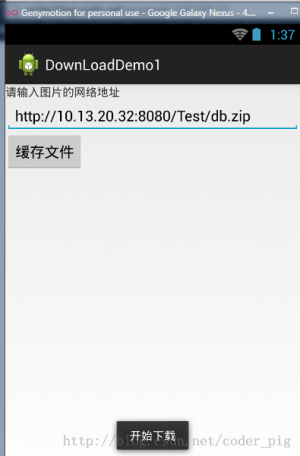Android 檔案下載(1)
本節引言:
又是一個深坑,初學者慎入...本節將從普通的單線程下載-> 普通多線程下載-> -> 以及一個很實用的範例:利用Android那隻DownloadManager更新apk 並覆蓋安裝的實現代碼!好的,這樣看上去,本節還蠻有趣的,開始本節內容! PS:我們把整個完整的多執行緒續傳到下一節!
1.普通單執行緒下載檔案:
直接使用URLConnection.openStream()開啟網路輸入流,然後將流寫入到檔案中!
核心方法:
public static void downLoad(String path,Context context)throws Exception
{
URL url = new URL(path);
InputStream is = url.openStream();
//截取最后的文件名
String end = path.substring(path.lastIndexOf("."));
//打开手机对应的输出流,输出到文件中
OutputStream os = context.openFileOutput("Cache_"+System.currentTimeMillis()+end, Context.MODE_PRIVATE);
byte[] buffer = new byte[1024];
int len = 0;
//从输入六中读取数据,读到缓冲区中
while((len = is.read(buffer)) > 0)
{
os.write(buffer,0,len);
}
//关闭输入输出流
is.close();
os.close();
}執行結果:


2.普通多執行緒下載:
我們都知道使用多執行緒下載檔案可以更快地完成檔案的下載,但是為什麼呢?
#答:因為搶佔的伺服器資源多,假設伺服器最多服務100個使用者,伺服器中的一個線程 對應一個使用者100個執行緒在電腦中並發執行,由CPU劃分時間片輪流執行,加入a有99個線程 下載檔案,那麼相當於佔用了99個使用者資源,自然就有用較快的下載速度
#PS:當然不是執行緒越多就越好,開啟過多線程的話,app需要維護和同步每條線程的開銷, 這些開銷反而會導致下載速度的降低,另外還和你的網速有關!
多線程下載的流程:
- 獲取網路連線
- 本機磁碟建立相同大小的空白檔案
- 計算每個執行緒需從檔案哪個部分開始下載,結束
依序創建,啟動多條執行緒來下載網路資源的指定部分
PS:這裡直接建立一個Java項目,然後在JUnit裡執行指定方法即可,
核心程式碼如下:
public class Downloader {
//添加@Test标记是表示该方法是Junit测试的方法,就可以直接运行该方法了
@Test
public void download() throws Exception
{
//设置URL的地址和下载后的文件名
String filename = "meitu.exe";
String path = "http://10.13.20.32:8080/Test/XiuXiu_Green.exe";
URL url = new URL(path);
HttpURLConnection conn = (HttpURLConnection) url.openConnection();
conn.setConnectTimeout(5000);
conn.setRequestMethod("GET");
//获得需要下载的文件的长度(大小)
int filelength = conn.getContentLength();
System.out.println("要下载的文件长度"+filelength);
//生成一个大小相同的本地文件
RandomAccessFile file = new RandomAccessFile(filename, "rwd");
file.setLength(filelength);
file.close();
conn.disconnect();
//设置有多少条线程下载
int threadsize = 3;
//计算每个线程下载的量
int threadlength = filelength % 3 == 0 ? filelength/3:filelength+1;
for(int i = 0;i < threadsize;i++)
{
//设置每条线程从哪个位置开始下载
int startposition = i * threadlength;
//从文件的什么位置开始写入数据
RandomAccessFile threadfile = new RandomAccessFile(filename, "rwd");
threadfile.seek(startposition);
//启动三条线程分别从startposition位置开始下载文件
new DownLoadThread(i,startposition,threadfile,threadlength,path).start();
}
int quit = System.in.read();
while('q' != quit)
{
Thread.sleep(2000);
}
}
private class DownLoadThread extends Thread {
private int threadid;
private int startposition;
private RandomAccessFile threadfile;
private int threadlength;
private String path;
public DownLoadThread(int threadid, int startposition,
RandomAccessFile threadfile, int threadlength, String path) {
this.threadid = threadid;
this.startposition = startposition;
this.threadfile = threadfile;
this.threadlength = threadlength;
this.path = path;
}
public DownLoadThread() {}
@Override
public void run() {
try
{
URL url = new URL(path);
HttpURLConnection conn = (HttpURLConnection) url.openConnection();
conn.setConnectTimeout(5000);
conn.setRequestMethod("GET");
//指定从什么位置开始下载
conn.setRequestProperty("Range", "bytes="+startposition+"-");
//System.out.println(conn.getResponseCode());
if(conn.getResponseCode() == 206)
{
InputStream is = conn.getInputStream();
byte[] buffer = new byte[1024];
int len = -1;
int length = 0;
while(length < threadlength && (len = is.read(buffer)) != -1)
{
threadfile.write(buffer,0,len);
//计算累计下载的长度
length += len;
}
threadfile.close();
is.close();
System.out.println("线程"+(threadid+1) + "已下载完成");
}
}catch(Exception ex){System.out.println("线程"+(threadid+1) + "下载出错"+ ex);}
}
}
}運行截圖:
如圖,使用多執行緒完成了對檔案的下載!雙擊exe檔可運行,說明檔並沒有損壞!


注意事項:
- int filelength = conn.getContentLength(); //取得下載檔案的長度(大小)
- RandomAccessFile file = new RandomAccessFile(filename, "rwd"); //該類別運行對檔案進行讀寫,是多執行緒下載的核心
- nt threadlength = filelength % 3 == 0 ? filelength/3:filelength+1; //計算每個執行緒要下載的量
- conn.setRequestProperty("Range", "bytes="+startposition+"-"); //指定從哪個位置開始讀寫,這個是URLConnection提供的方法
- //System.out.println(conn.getResponseCode()); //這個註解了的程式碼是用來查看conn的回傳碼的,我們前面用的都是200, 而針對多線程的話,通常是206,必要時我們可以透過呼叫該方法查看返回碼!
- int quit = System.in.read();while('q' != quit){Thread.sleep(2000);} //這段程式碼是做延時操作的,因為我們用的是本地下載,可能該方法運行完了,而我們的 線程還沒開啟,這樣會引發異常,這裡的話,讓用戶輸入一個字元,如果是'q'的話就退出
3.使用DownloadManager更新應用程式並覆蓋安裝:
下面的程式碼可以直接用,加入專案後,記得為這個內部廣播註冊一個篩選器:
AndroidManifest.xml
:import android.app.DownloadManager;
import android.content.BroadcastReceiver;
import android.content.Context;
import android.content.Intent;
import android.content.pm.ApplicationInfo;
import android.content.pm.PackageManager;
import android.database.Cursor;
import android.net.Uri;
import android.os.Bundle;
import android.os.Environment;
import android.support.v7.app.AppCompatActivity;
/**
* Created by Jay on 2015/9/9 0009.
*/
public class UpdateAct extends AppCompatActivity {
//这个更新的APK的版本部分,我们是这样命名的:xxx_v1.0.0_xxxxxxxxx.apk
//这里我们用的是git提交版本的前九位作为表示
private static final String FILE_NAME = "ABCDEFGHI";
@Override
public void onCreate(Bundle savedInstanceState) {
super.onCreate(savedInstanceState);
String endpoint = "";
try {
//这部分是获取AndroidManifest.xml里的配置信息的,包名,以及Meta_data里保存的东西
ApplicationInfo info = getPackageManager().getApplicationInfo(
getPackageName(), PackageManager.GET_META_DATA);
//我们在meta_data保存了xxx.xxx这样一个数据,是https开头的一个链接,这里替换成http
endpoint = info.metaData.getString("xxxx.xxxx").replace("https",
"http");
} catch (PackageManager.NameNotFoundException e) {
e.printStackTrace();
}
//下面的都是拼接apk更新下载url的,path是保存的文件夹路径
final String _Path = this.getIntent().getStringExtra("path");
final String _Url = endpoint + _Path;
final DownloadManager _DownloadManager = (DownloadManager) getSystemService(DOWNLOAD_SERVICE);
DownloadManager.Request _Request = new DownloadManager.Request(
Uri.parse(_Url));
_Request.setDestinationInExternalPublicDir(
Environment.DIRECTORY_DOWNLOADS, FILE_NAME + ".apk");
_Request.setTitle(this.getString(R.string.app_name));
//是否显示下载对话框
_Request.setShowRunningNotification(true);
_Request.setMimeType("application/com.trinea.download.file");
//将下载请求放入队列
_DownloadManager.enqueue(_Request);
this.finish();
}
//注册一个广播接收器,当下载完毕后会收到一个android.intent.action.DOWNLOAD_COMPLETE
//的广播,在这里取出队列里下载任务,进行安装
public static class Receiver extends BroadcastReceiver {
public void onReceive(Context context, Intent intent) {
final DownloadManager _DownloadManager = (DownloadManager) context
.getSystemService(Context.DOWNLOAD_SERVICE);
final long _DownloadId = intent.getLongExtra(
DownloadManager.EXTRA_DOWNLOAD_ID, 0);
final DownloadManager.Query _Query = new DownloadManager.Query();
_Query.setFilterById(_DownloadId);
final Cursor _Cursor = _DownloadManager.query(_Query);
if (_Cursor.moveToFirst()) {
final int _Status = _Cursor.getInt(_Cursor
.getColumnIndexOrThrow(DownloadManager.COLUMN_STATUS));
final String _Name = _Cursor.getString(_Cursor
.getColumnIndexOrThrow("local_filename"));
if (_Status == DownloadManager.STATUS_SUCCESSFUL
&& _Name.indexOf(FILE_NAME) != 0) {
Intent _Intent = new Intent(Intent.ACTION_VIEW);
_Intent.setDataAndType(
Uri.parse(_Cursor.getString(_Cursor
.getColumnIndexOrThrow(DownloadManager.COLUMN_LOCAL_URI))),
"application/vnd.android.package-archive");
_Intent.addFlags(Intent.FLAG_ACTIVITY_NEW_TASK);
context.startActivity(_Intent);
}
}
_Cursor.close();
}
}
} 4.參考程式碼下載:
一般單一執行緒下載檔案:DownLoadDemo1.zip普通多執行緒下載檔案:J2SEMulDownLoader.zip
本節小結:
好的,本節給大家介紹了普通單線程以及多線程下載文件,還有利用Android自帶DownManager來 下載更新APK,然後覆蓋的實作!相信會對大家的實際開發帶來便利,好的,就說這麼多,謝謝~









